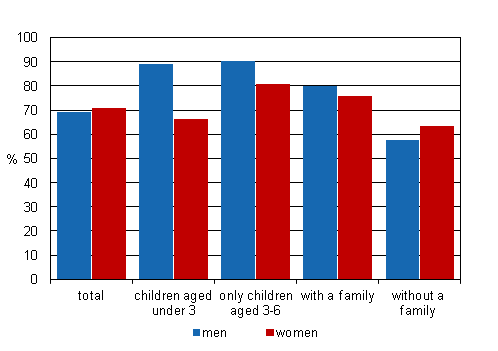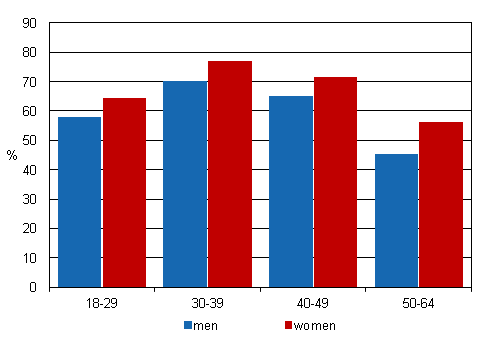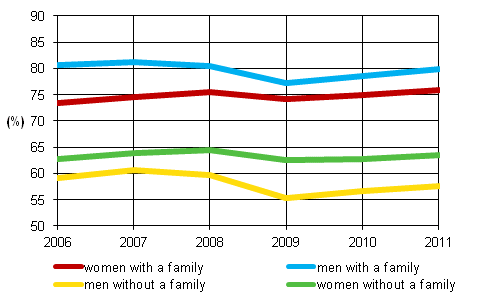Published: 22 March 2013
Two-thirds of mothers of children aged under three employed
According to Statistics Finland's employment statistics, the employment rate of mothers of children aged under three was 66.4 per cent in 2011. In all, 89.1 per cent of fathers of same-age children were working. The employment rate of all persons aged 18 to 64 was 69.9 per cent in 2011.
Employment rate of persons aged 18 to 64 by sex, family status and age of children

Parents of children of day care age most at work
In 2011, the employment rate of 18 to 64-year-old men with a family was 79.8 per cent. Families are formed by married or cohabiting couples and those in registered partnerships living together and sin-gle parents with their children. Children living in the same accommodation are counted in the family.
The employment rate was highest, 90.3 per cent, for those men in whose family children were aged three to six. In all, 70.2 per cent of married or cohabiting men of families without children were working. Regardless of the family status, the employment rate of all men aged 18 to 64 was 69.0 per cent.
The employment rate of all women aged 18 to 64 was slightly higher than that of men: 70.9 per cent. Parenthood of families with children lowers the employment rate of women especially among those living alone with children aged under three: their employment rate was 44.3 per cent.
The employment rate of married or cohabiting mothers of children aged under three, 68.8 per cent, was, however, nearly as high as that of women in the whole age group. Among women the employ-ment rate was also highest for mothers of children aged three to six: 80.7 per cent of them were at work.
Employment rate of men not belonging to a family low
The employment rate of men not belonging to a family, 57.6 per cent, was 22.2 percentage points lower than that of men belonging to a family, 79.8 per cent. Among women the difference was not as large: the employment rate of women with a family was 12.3 percentage points higher than that of those not belonging to a family.
Examined by age group, the difference between men belonging and not belonging to a family was at its highest, at 24.4 percentage points, in the 40 to 49 age group, where 89.6 per cent of men with a family were working. Of men without a family 65.2 per cent were working.
The employment rate of men not belonging to a family was 5.9 percentage points lower than that of women not belonging to a family. The difference was largest, 10.9 percentage points, in the over 50 and older age groups: 56.5 per cent of women of this age not belonging to a family were working, while men's employment rate was 45.5 per cent.
Employment rate of those not belonging to a family in 2011 by age and sex

The economic crisis earlier and more deeply visible in men's employment
The employment rate of both women belonging and not belonging to a family has risen from 2006 to 2011. The employment rate of women with a family went up by 2.4 percentage points and that of women without a family by 0.8 percentage points.
The employment rates of both men with and without a family were in contrast lower in 2011 than in 2006. In 2011, the employment rate of men with a family was 0.8 percentage points lower than in 2006. The fall in the employment rate of men not belonging to a family was 1.6 percentage points between 2006 and 2011.
The employment effects of the economic crisis started to be visible in men's employment rate already in 2008, when the employment rate of men with a family went down by 0.9 percentage points and that of men without a family by 1.0 percentage points compared with 2007. In 2009, the employment rate fell in both groups of men: for those with a family by 3.3 percentage points and for those without a family by 4.5 percentage points.
The economic crisis could be seen as a temporary dip in women's employment in 2009, when the employment rate of women with a family went down by 1.4 percentage points and that of women without a family by 2.1 per cent. The employment rates of all groups have risen in 2010 and 2011.
Employment rate of persons aged 18 to 64 by family status and sex in 2006–2011

Source: Employment Statistics, Statistics Finland
Inquiries: Jaana Huhta 09 1734 2632, tyossakaynti@stat.fi
Director in charge: Riitta Harala
Publication in pdf-format (230.3 kB)
- Tables
-
Tables in databases
Pick the data you need into tables, view the data as graphs, or download the data for your use.
Appendix tables
Updated 22.3.2013
Official Statistics of Finland (OSF):
Employment [e-publication].
ISSN=2323-6825. Main type of activity and status in occupation 2011. Helsinki: Statistics Finland [referred: 8.12.2025].
Access method: http://stat.fi/til/tyokay/2011/02/tyokay_2011_02_2013-03-22_tie_001_en.html

